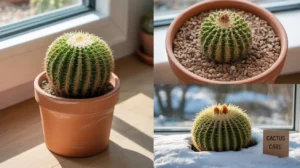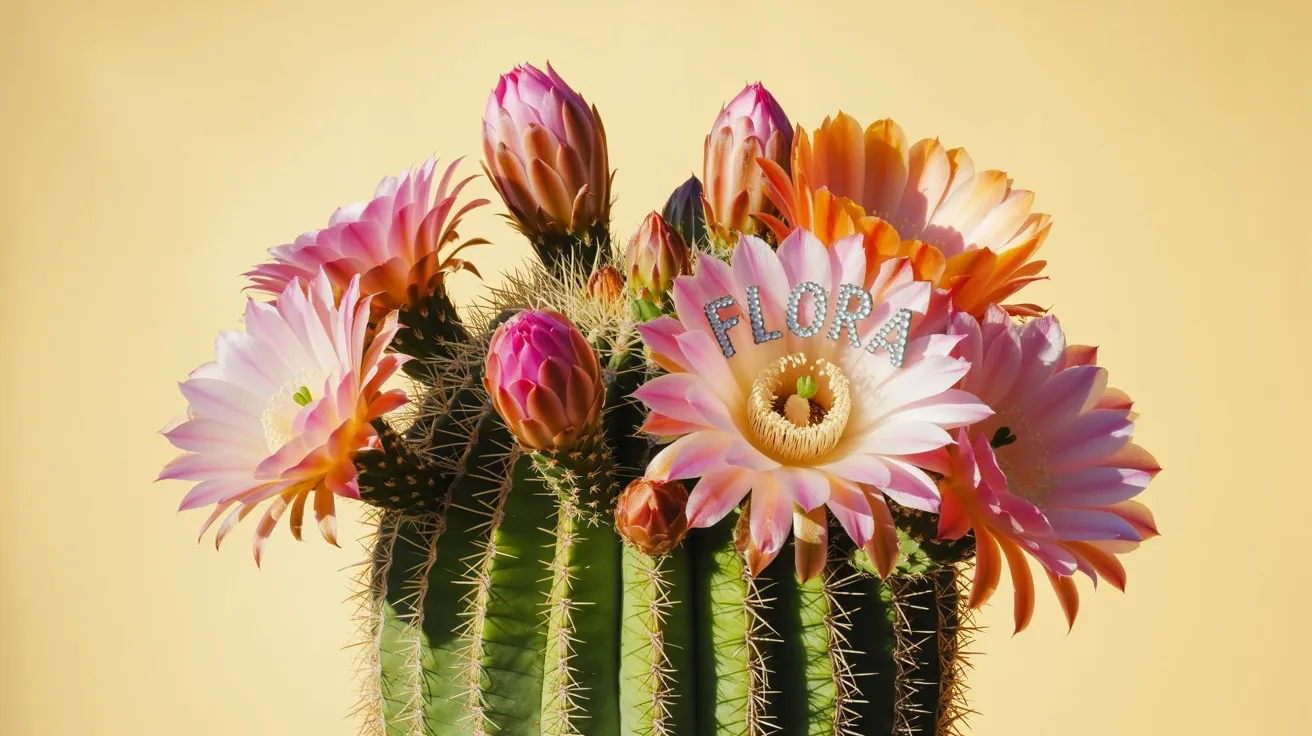Most people think a cactus is just a spiky green plant that sits in the sun and doesn’t do much. It looks dry, tough, and plain. But here’s a fun surprise: some cactus species grow big, beautiful flowers!
Yes, really! There are cactus plants that bloom with bright flowers in colors like pink, orange, yellow, red, and white. These flowers can be round, wide, and full of color — and they often appear when you least expect it. Some cactus flowers only bloom at night. Others last just one day. That’s what makes them so special — they’re rare, but they’re amazing when they show up.
These flowering cactus species are perfect for small spaces, windowsills, or gardens. They don’t need much water, and they can live in sunny places where other plants can’t. Even though they grow in dry soil and hot weather, they still manage to bloom — and that’s pretty magical.
In this post, you’ll learn about five types of cactus that grow stunning flowers. Whether you’re new to plants or already love them, these cacti will change the way you see them. Even the roughest plants can surprise you — just like people.
Table of Contents
ToggleWhat Makes Cactus Flowers So Magical?
Most people think cacti are just plain, spiky plants that don’t do much. But flowering cactus species are very different — their blooms are rare and full of wonder. Imagine a plant growing in the hot, dry desert suddenly showing a bright flower. That’s like nature’s surprise party!
One reason cactus flowers are so special is because they don’t bloom often. Some only open once a year, and you have to watch carefully to catch them. Others bloom only at night, hiding their beauty until the moon comes up. And some flowers last just a single day before fading away.
This makes each bloom feel like a magical event. It’s not just about beauty — it’s about patience and timing. Growing a flowering cactus teaches you to appreciate the small, rare moments in life.
So when a cactus flower opens, it’s a sign of hope and life — a reminder that even tough plants can create amazing beauty.
Meet the Bloomers: 5 Cactus Species That Steal the Show

1. Echinopsis – The Trumpet Flower Star
The Echinopsis cactus is round and plump with thick ribs and soft spines. When it blooms, it surprises everyone with large, trumpet-shaped flowers that come in bright pink, fiery orange, or pure white. These blooms open mainly in the evening and last only a day or two, but their beauty is unforgettable.
This cactus loves bright sunlight but needs only a little water — just enough to keep the soil dry between watering. You can grow Echinopsis inside your home near a sunny window or outdoors in warm, dry places.
Why is it special? Because it transforms from a simple green ball to a bright flower showstopper! Bonus tip: Avoid watering too much because this cactus hates soggy roots.
2. Epiphyllum (Orchid Cactus) – The Nighttime Flower Magic
The Epiphyllum, also called the “Orchid Cactus,” is different from other cacti. It has long, flat, leaf-like stems instead of spines. Its flowers are huge, showy, and bloom at night. The petals are soft and wide, usually in shades of white, pink, or deep red. The sweet smell makes these flowers even more special.
This cactus prefers bright but indirect light and should be watered only when the soil feels dry. It grows well inside houses or in shady outdoor spots.
People love Epiphyllum because its blooms are rare and magical, appearing only at night and disappearing by morning. Bonus tip: If you want to see the flowers, stay up late or check at dawn!
3. Mammillaria – The Crowned Miniature
The Mammillaria cactus is small and globe-shaped, covered in tiny spines that look like little stars. Its most charming feature is the ring of small flowers that grow around its top like a pretty crown. These flowers come in cheerful colors such as pink, white, and yellow and can last several days.
This cactus loves bright sunlight and needs watering only when the soil is completely dry. It’s perfect for tiny pots on your desk or windowsill.
Why choose Mammillaria? Its flower crown makes it one of the cutest flowering cactus species out there! Bonus tip: When watering, try not to wet the flower ring to keep the blooms fresh longer.
4. Gymnocalycium – The Easy-Blooming Beauty
The Gymnocalycium cactus is small, round, and has soft spines. Its flowers are gentle pastels like light pink, white, and soft peach, blooming during the day and lasting for several days.
It enjoys bright light but not harsh direct sunlight all day. Water only when the soil is dry. You can grow this cactus indoors or outdoors in warm weather.
It’s a perfect cactus for beginners because it’s simple to care for and rewards you with beautiful flowers. Bonus tip: Rotate the plant every few days so flowers bloom evenly all around.
5. Rebutia – The Colorful Cluster
The Rebutia cactus is small and round but often grows in bunches, looking like a group of green balls. When it blooms, it surprises with many bright flowers in orange or red that almost cover the entire plant.
This cactus prefers bright, indirect sunlight and watering only when dry. It thrives indoors or outdoors in mild climates.
People love Rebutia because it’s easy to grow and its bright flowers light up any space. Bonus tip: If your cactus grows many baby plants, gently separate them to keep the plant healthy and blooming.
These flowering cactus species are some of the best choices if you want a cactus that gives more than just green spikes. They bring color, life, and surprise to your home or garden with their beautiful blooms. Whether you want a cactus flower for indoors or a splash of color outside, these species deliver joy with little effort.
Growing flowering cacti means patience and care, but when those flowers bloom, you get a special reward — a small miracle of nature right in your hands.
Want Blooms? Here’s How to Help Your Cactus Flower
Many plant lovers bring home a cactus hoping it will one day bloom with stunning flowers. But when weeks turn into months with no sign of color, it’s easy to feel disappointed. What most people don’t realize is that getting a cactus to flower is less about luck — and more about creating the right environment.
In this guide, you’ll learn how to make your cactus bloom, even if it hasn’t shown signs for years. We’ll break it down into simple, practical steps that even a 10-year-old can understand. Whether you grow cactus indoors or outdoors, these methods work — and they’re based on how cacti naturally grow and flower in the wild.
1. Prioritize Sunlight — It’s a Bloom Booster
The #1 reason most cacti don’t flower? Lack of sunlight. These plants come from deserts, where the sun shines hard for hours every day. If your cactus isn’t getting at least 6 hours of bright, direct sunlight, it won’t bloom — no matter how well you water or feed it.
Tips:
- Place indoor cacti near a south-facing window
- If you live in a cloudy area, use a grow light
- Outdoors, keep them in a full-sun spot (not filtered shade)
Avoid this: Moving your cactus too often. Let it adapt to a spot and stay there.
2. Respect the Dormant Phase (It’s Nature’s Secret Trick)
Most flowering cacti need a resting period in winter to prepare for blooming. In the wild, this happens naturally due to colder temperatures and less rainfall. Indoors, you’ll need to copy that pattern.
Here’s how to trigger flowering through dormancy:
- In winter, reduce watering to once a month or less
- Keep the cactus in a cooler spot (around 50–55°F or 10–13°C)
- Don’t feed or move it too much
- No repotting during this time
This phase tells your cactus it’s time to slow down, store energy, and prepare to flower in the spring or summer. Without this rest, your cactus may stay healthy — but it likely won’t bloom.
3. Choose the Right Soil – It Affects Flowering Too
Soil isn’t just dirt — it’s the foundation of plant health. Many cacti struggle to bloom because they’re planted in heavy, moisture-trapping soil.
What your cactus needs:
- A fast-draining soil mix (sand + perlite + small gravel)
- No peat-based soils, as they hold too much moisture
- A pot with drainage holes to prevent root rot
Pro tip: You can buy a cactus-specific potting mix, or make your own using 2 parts coarse sand, 1 part perlite, and 1 part compost or garden soil.
4. Water Less — But Water Smart
Cactus watering is tricky. Too little and the plant dries out. Too much and the roots rot. If your goal is flowering, you must get the balance right.
How to water for flowering:
- Let the soil dry completely between watering
- In growing season (spring/summer), water every 2–3 weeks
- In dormant season (winter), water once a month or less
- Use room-temperature water and pour slowly
Check this before watering: Stick your finger in the soil up to your second knuckle — if it’s dry, it’s time to water.
5. Feed, But Don’t Overfeed
Yes, cacti do benefit from fertilizer — but too much food can stop flowering. During active growing months, your cactus needs a boost, but it should be the right kind.
Use:
- A low-nitrogen fertilizer with a ratio like 5-10-10 or 2-7-7
- Apply only in spring and early summer (never during dormancy)
- Use liquid cactus food every 4–6 weeks
Avoid fertilizers that are rich in nitrogen — they promote leaf growth, not flowers.
6. Don’t Make These Flower-Killing Mistakes
Even small habits can stop your cactus from blooming. Avoid these common errors:
- Repotting right before or during blooming season — this stresses the plant
- Overwatering after buds appear — it can cause flower buds to drop
- Changing location too often — sudden changes in light or temperature interrupt blooming cycles
- Ignoring pests — especially mealybugs, which attack cactus buds
7. Be Patient – Cactus Flowers Are a Reward, Not a Promise
Some cacti bloom after 2–3 years. Others take 5–10 years, especially if grown from seed. It depends on the species, environment, and consistency of care.
But when the flower finally opens — it’s magical. Some last only a day. Others bloom at night and disappear by morning. This rare moment becomes more meaningful because you waited.
Final Takeaway
If you want your cactus to bloom, it’s not about fancy tricks. It’s about understanding the natural life cycle of a cactus, and providing the right light, water, rest, soil, and time.
Don’t rush it. Don’t overdo it. Let nature work — and it will reward you with a flower that feels like a gift.

Cactus Flowering: Your Top Questions Answered
Can cactus bloom indoors?
Yes, cactus can bloom indoors if they get enough sunlight. Place them near a sunny window, use well-draining soil, and avoid overwatering. Some indoor-friendly bloomers include Echinopsis and Rebutia.
How often do cacti flower?
Most cacti bloom once a year, usually in spring or summer. However, species like Echinopsis may bloom multiple times if healthy. Proper light, watering, and a rest period help trigger blooming.
At what age do cacti start blooming?
Cacti usually bloom after 2–5 years, depending on the species. Fast bloomers like Rebutia bloom early, while slow types may take longer. Healthy care and consistent conditions speed up the process.
Why do some cacti bloom at night?
Night-blooming cacti open after dark to attract nighttime pollinators like moths. It protects the flowers from extreme daytime heat. Species like Epiphyllum bloom at night with large, fragrant flowers.
Even the Toughest Plants Can Surprise You
Cactus flowers show us that even the toughest plants can produce stunning beauty. These blooms add bright colors and life to any space, whether indoors or outdoors. If you want to see this magic, try growing a popular species like Echinopsis or Mammillaria. With proper sunlight and care, your cactus can bloom and bring joy.
Starting with one flowering cactus is a simple way to enjoy nature’s wonders at home. Have you seen a cactus bloom? Share your favorite flowering cactus or post a picture to inspire others. Watching a cactus flower is a special experience that’s worth the wait!



